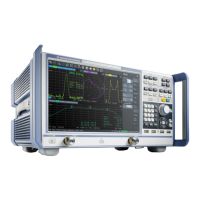Glossary: Frequently Used Terms
R&S
®
ZNB/ZNBT
1454User Manual 1173.9163.02 ─ 55
L
Limit check: Comparison of the measurement results with the limit lines and display of
a pass/fail indication. An acoustic warning can be generated in addition if a limit is
exceeded.
Limit line: A limit line is a set of data to specify the allowed range for some or all
points of a trace. Typically, limit lines are used to check whether a DUT conforms to the
rated specifications (conformance testing).
Load match error: Measurement error caused by a mismatch of the analyzer's
receive (load) port causing part of the signal transmitted through the DUT to be reflec-
ted off the receive port so that it is not measured there. The load match error can be
corrected by means of a two-port calibration (except normalization).
M
Marker: Tool for selecting points on the trace and for numerical readout of measured
data. A marker is displayed with a symbol (a triangle, a crossbar or a line) on the trace;
its coordinates are shown in the marker info field.
Mathematical trace: Trace that is calculated according to a mathematical expression,
e.g. the one defined in the Define Math dialog. The expression is a mathematical rela-
tion between constants and the data or memory traces of the active recall set.
Measurement point: Result of the measurement at a specified stimulus value (fre-
quency/power/time).
Measurement result: Set of all measurement points acquired in a measurement (e.g.
a sweep). The measurement result is displayed in a diagram area and forms a trace.
Memory trace: Trace that is associated to a data trace and stored in the memory. Data
traces and the associated memory traces share the same channel and scale settings.
Alternatively, memory traces can be imported from a file.
Mixer: Device that converts an RF signal at one frequency into a signal at another fre-
quency. The frequency that is to be shifted is applied at the RF input and the frequency
shifting signal (from a local oscillator, LO) is applied to the RF mixer's LO port, resulting
in an output signal at the mixer's Intermediate Frequency (IF) port.
P
Partial measurement: Measurement at a specified stimulus value maintaining definite
hardware settings. Depending on the measurement type, several partial measure-
ments may be needed to obtain a measurement point. A full n-port S-parameter mea-
surement requires n partial measurements with n different drive ports.
Peak: Local maximum or local minimum (dip) on the trace. In the Trace - Search
menu, it is possible to define a minimum excursion that both types of peaks must have
to be considered valid.

